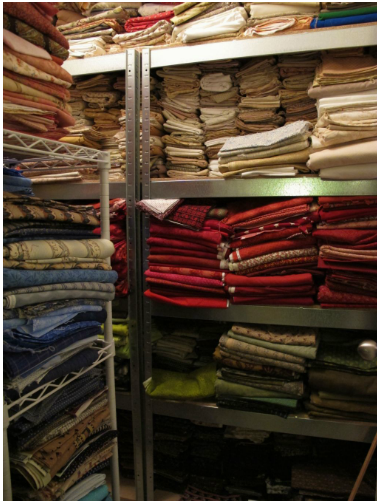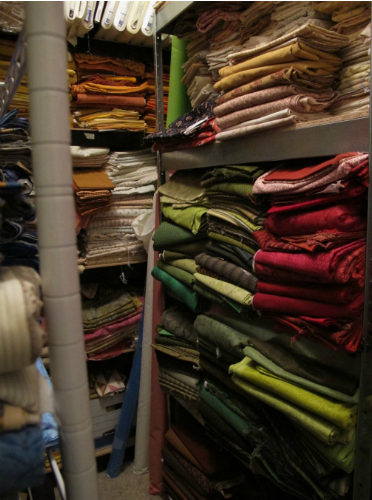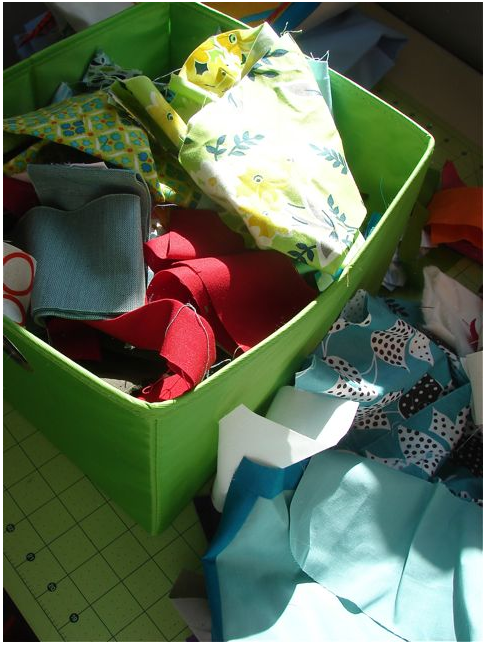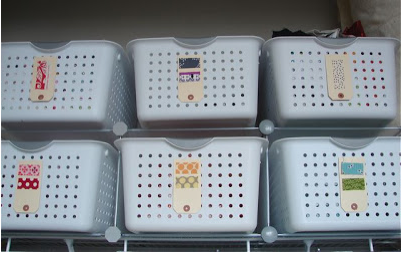This week's workout is to sort through the fabric that you are keeping. This should ideally be a LOT LESS than before, which will enable you to more easily find and use pieces when working on a project. Typically one might sort by sizes such as:
- Yard cuts
- Fat quarters
- Fat eighths
- Scraps smaller than fat eighths
But, before you start sorting, here are some things to think about regarding the type of quilter you are. With each of our questions, we have a solution based on an artist who works in this particular manner. Maybe you have a suggestion you might want to share with others.
- Do you love to work with lots of tiny scraps?
- Do you like to make quilts that require medium-sized pieces of fabric?
- Do you prefer to have large pieces of fabric that will be cut down to size?
- Do you love to make traditional blocks?
- Do you prefer to work in color families?

(photo from Susan Carlson)
1. Susan Carlson's (Show 801) work requires thousands of tiny scraps. In fact, she has even admitted to raiding the trash cans of her students after a class. Because she works with so many tiny bits of fabric, she finds it useful to store them in antique suitcases. (See them lined up under the shelving!) When the case is shut, they look nice, and no on is the wiser.
She also sorts by color and size. For smaller bits that aren't relegated to the suitcases, she uses those plastic salad containers you get at the grocery stores. Brilliant! They are cheap, see-through, and you most likely have a few in your fridge right now.
New shelving, which lines the walls in her studio keeps things arranged for easy access.
 |
2.Libby Lehman's (Show 112, 513) studio is a wealth of ideas for organizing in a small space. We love her method of storing (and showcasing) medium pieces of fabric by using foam core cut to accomodate her below table height bookcase shelving.


3.Sue Garman (Show 304) studio includes a walk-in closet dedicated to her larger fabric pieces. They are sorted by color family for easy access.

(Photo by Gregory Case Photography)
4. Bonnie Hunter (Show 1410) loves scrap quilts and sorts to streamline her work productivity. Once a quilt is completed, all the remaining fabric is cut into strips 12" or longer. Shorter pieces of fabric become bricks. Here is her preferred sorting system:
Sort strips in sizes of:
1-1⁄2”, 2”, 2-1⁄2”, 3-1⁄2”
-
The 1-1⁄2”, 2”, and 2-1⁄2” can be combined in different combinations and can then play with the 3-1⁄2”.
Cut squares into these sizes: -
1-1⁄2”, 2”, 2-1⁄2”, 3-1⁄2”
-
Cut bricks in these sizes:
2” x 3-1⁄2”, 2-1⁄2” x 4-1⁄2
-
- A brick is the height of one square, with the width of two squares, plus seam allowance, (twice as wide as it is tall, plus seam allowance).
-
- Bricks can be used for flying geese and star point units, as well as on their own.
-
- You can make any number of traditional blocks through combinations of these sizes since they work together with each other.
-
- Store strips in drawers by strip width and color families.
-
- Stack strips on top of each other, and fold them over and over into a long jelly roll, so that they fit in a gallon zip lock (which I leave unclosed for air circulation).
-
- It is really easy this way to grab the sizes of strips I need for any block or project, unroll the stack, choose what I need, roll it back up and put it away.
-


(Photos from Jacquie Gering)
5. Jacquie Gering (Show 1202) works in lareger pieces of fabric that are grouped by color family. After sorting through the box filled with scraps that get tossed under her sewing table, the fabrics are grouped by color into small white laundry baskets. Each basket receives a tag that identifies the basket of fabrics.
Now that you have seen several ideas, it's time to fire up the crock pot with your favorite recipe and get started sorting your fabrics. Looking for a new easy meal idea? We have two of Lilo's family favorites for cold weather days: Lentil Soup or Beef and Barley Soup. Both take very little prep work and will simmer along in the crock pot while you work away. Then, when it's time for dinner, all you need is to set the table.
If you have a suggestion of what works for you, we encourage you to share them.
Click below for the recipes:
Both Soups Combined Into One Document




.jpg)



All of our Organization articles fall under the heading Let's Get Organized. That way you can keep up if you miss a week or two.
Lilo
Multi color fabrics have been sorted into 6 Ikea wire sliding bins by value (Grace Errea). I initialing used my camera (use your I phone picture screen set to black/white) to sort everything into light, medium light, etc. It works for me! And it makes it easier to put fabrics back where they belong if I don't use them.
Next phase -deli counter plastic boxes to sort scraps by color. (Superbowl, here I come!) They will then go with the bigger pieces of similar color.
RSS feed for comments to this post